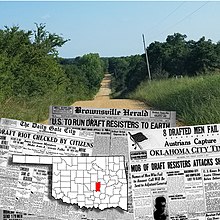| Green Corn Rebellion | |||||
|---|---|---|---|---|---|
| Part of the American Theater of World War I and the Revolutions of 1917–1923 | |||||
 The Green Corn Rebellion was centered in rural Seminole County in southeastern Oklahoma. | |||||
| |||||
| Belligerents | |||||
| Pontotoc Rebels |
| ||||
| Commanders and leaders | |||||
| Working Class Union (?) | Woodrow Wilson | ||||
| Strength | |||||
| 800 to 1,000? | Thousands | ||||
| Casualties and losses | |||||
|
3 killed 450 arrested | |||||
The Green Corn Rebellion was an armed uprising that took place in rural Oklahoma on August 2 and 3, 1917. The uprising was a reaction by European-Americans, tenant farmers, Seminoles, Muscogee Creeks, and African-Americans to an attempt to enforce the Selective Draft Act of 1917.[1] The name "Green Corn Rebellion" was a reference to the purported plans of the rebels to march across the country and to eat "green corn" on the way for sustenance.[2] They hoped to be joined by thousands of sympathizers, march to Washington, D.C., overthrow the federal government, abolish the draft, and end U.S. involvement in the war. Many of the rebels were aligned with the Socialist Party of America.[3]
Betrayed by an informer in their midst, the country rebels met with a well-armed posse of townsmen. Shots were exchanged and three people killed. In the aftermath of the incident, scores of arrests were made and the Socialist Party of America, which had been strong in the region, was discredited in the public eye for allegedly having attempted to foment revolution. The incident became a pretext for national reprisals against the Industrial Workers of the World and the Socialist Party of America.[4]
- ^ Chang 187
- ^ Sellars, Nigel Anthony. "Green Corn Rebellion," Encyclopedia of Oklahoma History and Culture. Accessed March 1, 2015.
- ^ Cite error: The named reference
Burbank134was invoked but never defined (see the help page). - ^ “Socialist gets 20 years for draft resistance” from The Los Angeles Herald, June 12, 1918